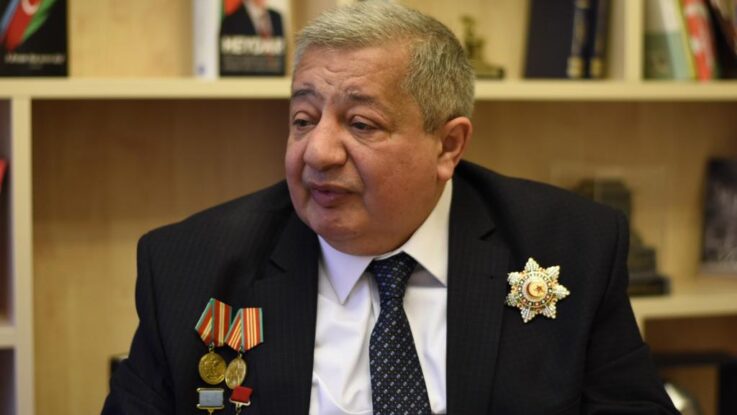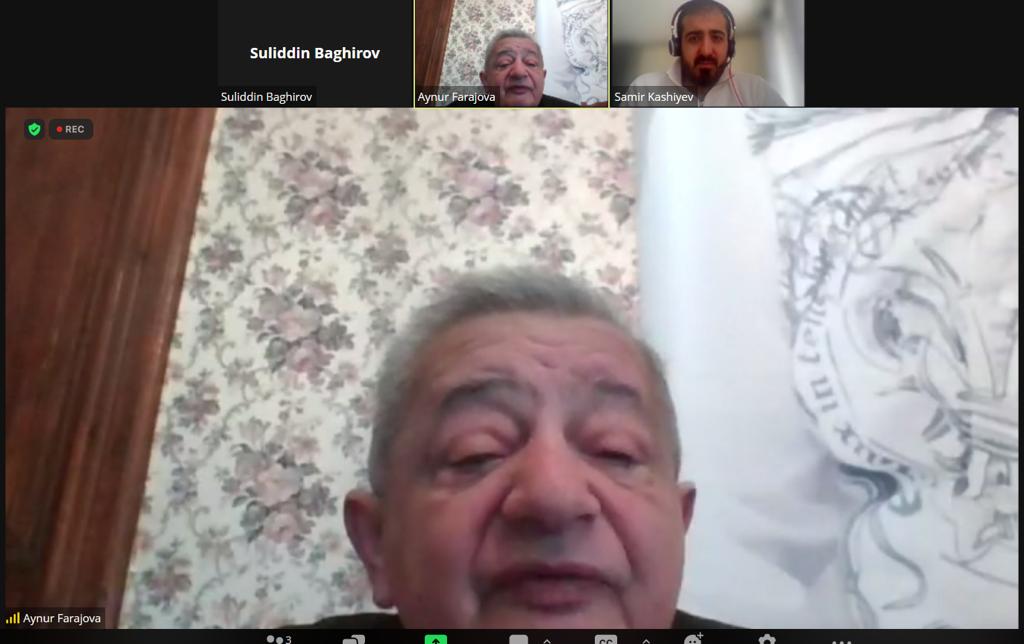
It is difficult to forget the pain and human tragedies caused by wars. 31 years ago, during the First Karabakh War, the small town of Khojaly, located in the Karabakh region of Azerbaijan, witnessed one of the most terrible tragedies of the 20th century. 31 years later, as members of Azerbaijan Diaspora Youth, we decided to return to those difficult days and talked with Asad Farajov, one of the living witnesses of those days. He is the man in military uniform in the famous photo that many of us remember.
Our interlocutor was born in 1961 in Ganja. He served in the Soviet military units fighting in Afghanistan from 1979-81. Taking into account all these services, he was sent to the Faculty of Law of the Higher School of the Ministry of Internal Affairs of the USSR in Ryazan in 1981 to study. In 1989, he was appointed head of a large correctional labor colony located in the Arkhangelsk region. From 1993 to 2000, he worked as a judge at the Military Tribunal in Azerbaijan. Mr. Farajov worked as an assistant to former Minister of Justice Alisahib Orujov.
We start our interview about those days with his arrival in Karabakh.
***

When and under what conditions did you come to Karabakh?
The events of the 1990s had a very negative impact on us. After sending my family to Ganja, I prepared myself to be assigned to Baku. I was appointed to Karabakh at the end of 1991 and started working in the extraordinary representative office of the President, and later as the head of the human rights department in the apparatus.
Events happened unexpectedly. Armenian militants were fully prepared for illegal actions and attacks against ethnic Azerbaijanis. When we were there, support came from many regions. Unfortunately, political turmoil in the early years of independence became one of the reasons for the chaotic situation in the region.
The First Karabakh War was a big human tragedy. Thousands of innocent Azerbaijanis were killed in dozens of villages across Karabakh. Have other massacres committed by the Armenian armed forces before the Khojaly tragedy been documented? It is known that similar acts of mass killings have taken place in Malibeyli, Gushchular, Garadagly, and Aghdaban.
Those villages were exposed to sudden attacks. Before the events, the weapons of the local population were taken by Soviet authorities in 1991. Let me tell you a story from the Zangilan district, where the resistance of the community was at its peak. They fought against the armed Armenian militants with bare hands. Those people were very brave despite being surrounded by armed militants.
There was one person who was brave enough to document many Armenian atrocities, and that was Chingiz Mustafayev, a prominent Azerbaijani journalist. Chingiz Mustafayev and I stayed in the same room in a guest house in Aghdam, a city very close to Khojaly. When we received the news about the barbaric attacks against the town of Khojaly, Chingiz immediately decided to go to the site of the massacre. He told me that he has got a bulletproof vest.
Eventually, we decided that we should record everything to present the scale of the tragedy. It needs to be mentioned that there was a difference of 3-4 days between the first and second recordings. After publishing the first video, many journalists from Türkiye, France, Japan, Iran, and Russia decided to come. So, we accompanied the foreign journalists during the second flight to the site of the massacre. Chingiz told me that it is of crucial importance to show this to the world and see what these war criminals have done.
Mr. Farajov, you mentioned that you went to the site twice, but from whom did you get the information about the area exactly?
You know, we were able to contact some people by radio devices. We realized that many people were trying to leave the town and find rescue in Aghdam. When dozens of people started arriving in Aghdam, they told us that Armenian militants along with the soldiers of the 366th Guards Motor Rifle Regiment of the CIS killed old people, as well as women and children. We were not able to land in the town itself, as Armenian forces were shooting at helicopters. Therefore, we were able to in a nearby factory. After witnessing the horror in the area, it was clear that no humanitarian corridor was provided by Armenian militants for the civilians. That was another lie by Armenian separatists. On the first flight, there were dead bodies everywhere, and on the second flight, we realized that the remaining bodies were mutilated. We saw that the ears of the corpses were cut off and scalps were removed. Serj Sargsyan, a former president of Armenia himself confirmed the atrocities committed by Armenian forces. In an interview with Thomas de Waal, he clearly stated that “Azerbaijanis were thinking that Armenians could not kill women and children, and in Khojaly, Armenians were able to break that stereotype.”
You mentioned that there were many foreign journalists. How did they cover the massacre?
They were covering it widely. I have to mention that many of them were from Turkish media outlets. Foreign reporters helped us a lot to spread the truth about Khojaly. Thanks to Chingiz Mustafayev, as he was also trying to send recordings to various media outlets abroad.
As I look back at both wars in Karabakh, I realize that we have brave heroes, a great president, and a united nation. President Ilham Aliyev was able to unite all of us around the “iron fist.”
Also, I would like to highlight that in 2008, Mrs. Mehriban Aliyeva, our current Vice-President and the President of the Heydar Aliyev Foundation along with Ms. Leyla Aliyeva, a Vice-President of the foundation started a big campaign called “Justice for Khojaly.” I can assure you that after that the world began to know that such tragedies happened.
Back in Israel, our beloved friend Arye Gut, a prominent Israeli journalist was working very hard to spread the truth about Khojaly. The news related to the massacre has made headlines in the media many times. It also symbolized our multicultural values, as people from different nationalities, both living in Azerbaijan and abroad have put all efforts to support Azerbaijan.
We should also recognize the efforts of Richardas Lapaitis, a Lithuanian journalist, a kind person, and our friend, who was in Aghdam back in 1992 to cover the tragedy. He is a great supporter of our country and he loves Azerbaijan. I met him near the mosque in Aghdam.
Indeed, our nation has demonstrated unity, strength, and patience during hard times. The Second Karabakh War was a great example of unity when the people and the country’s leadership were in solidarity for one common goal.
Speaking of Chingiz Mustafayev. How would you describe him?
He was a very brave and zealous man. Chingiz was very dedicated to showing the events to the wider audience. He was my roommate and I witnessed his dedication to his nation and everyone around him. It is impossible to express, as no words can describe his character. Chingiz inspired many people, and millions of people believed in him. He was mortally injured in Nakhchivanik village, nearby Asgeran while recording the battle. Armenian militants shot him. I have never said it before, but I carried him to the ambulance in my arms. He died on the way to the hospital in Khindiristan, not far from Aghdam.
You have already mentioned a very interesting point, about these shootings, for example, at that time there was a similar report that some people were killed in different directions, not only along the Katik plain. If I’m not mistaken, some people were killed along the Asgeran direction. Are there any videos from that area as well?
No, there was no chance. In the beginning, the Armenian side deployed the armed forces around Khojaly using specific military tactics, opened fire with large-caliber weapons, and besieged it, after which they launched an attack. There was no way for people to get out of there, and people were taken captive in various directions outside the town. Asgeran was one of them. Then, when we launched a special operation around Asgeran, we were able to save many people and freed them from captivity. I have to mention that Seyidagha Movsumov, a brave cameraman was able to record some parts of the special operation. We rescued many prisoners from there. You probably know Valeh, a famous guitar player from Khojaly. Armenian militants broke Valeh’s hands, so he could never play again, and probably, you have heard about Ms. Durdana’s sad story in captivity. These stories are really painful. They show the level of atrocity against the residents of Khojaly.
How was the identification process of the corpses taken to the Aghdam Juma Mosque carried out?
Those who survived gathered in Aghdam Square. Allahverdi Baghirov, our national hero, and his group brought many dead bodies. When I brought one of the children, there was a child in her mother’s arms. As we have our religious customs, I carried the body of that child to the mosque. There, a miracle happened. I was informed that when the body of the child was being washed, she opened her eyes. She was alive. At that moment I was crying from excitement.
If I’m not mistaken, you haven’t seen her since that moment. Is it true?
I have seen her once, but never introduced myself.
You mentioned earlier that you were able to collect mostly children’s remains from that area. A few years ago, it was reported that the Armenian forces buried or burned the dead bodies of innocent civilians who remained in the area. Have you heard any information about this? What happened to the dead bodies of the people who remained there in the 90s?
After the events, Allahverdi Baghirov went to talk with them and they agreed to allow us to collect the dead bodies. We buried all the dead bodies we found in a place called Uzundara, in the vicinity of Aghdam. That area became a large cemetery where hundreds of people were buried. Later, during the occupation of Aghdam, the cemetery was razed to the ground by Armenian forces.
After witnessing so many tragedies and the death of hundreds, how do you feel about humanity now? What has changed?
It is hard to recall those days. The war has reshaped my life philosophy, and I became attached to people. I believe that we are all created by God, and therefore, we need to respect each other. The Armenian side needs to understand that peaceful coexistence is necessary for everyone in the region.
Do you think our future generation will forget the events in Khojaly, as humans tend to forget many things?
You know, it is impossible to forget. These tragic pages of history should not be forgotten. Our youth needs to know the truth. As you know, every year thousands of people march to the “Ana Harayı” (“Mother’s Cry”) monument to commemorate the victims of the Khojaly Genocide. People have to know about the sufferings of innocent people. I believe the next generations will never forget this pain.
What would be your main message to the upcoming generations?
My message to our young people is that they should not forget the massacres in Khojaly, Agdaban, Garadaghly, and all other places. This is written in our history. Peace is important, but we should never forget about the past because once you forget the pain of the war, it comes back immediately.
***
Samir Kashiyev Suliddin Baghirov
Azerbaijan Diaspora Youth (Lithuania) Azerbaijan Diaspora Youth (Poland)

Leave a Reply